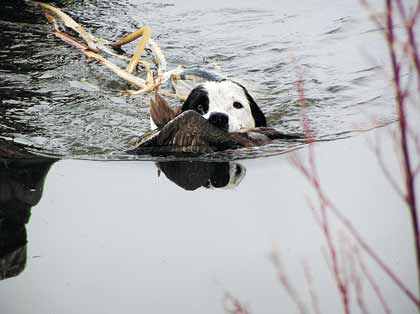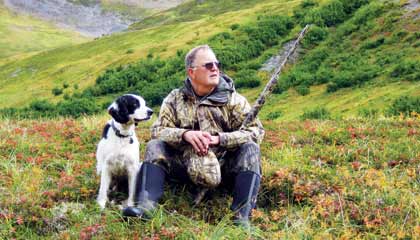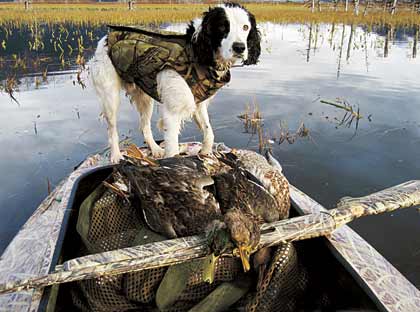An Alaskan Hunter Finds His "Once In A Lifetime" Dog.
By Mike Chihuly
Four years ago, just before Christmas in Ninilchik, Alaska, my wife and I awaited the arrival of my daughter and son-in-law who were driving south from that deep-freeze of the Interior called Fairbanks. They were both going to college at the time and now returning home for the holidays with a new German shorthair puppy that they had ordered and purchased from a kennel in Minnesota. The puppy they named "Sage" was arriving at the Ted Stevens International Airport in Anchorage.
Michelle and Reed were to pick up their new pup and continue on down the Seward and then Sterling Highways to Ninilchik, where Shirley and I waited to see the pointing dog breed that I had no previous experience with and had only read about in magazines like Gun Dog. We smiled and cooed over this cutest of puppies with the shortest of hair and an abundance of ticking as Michelle and Reed showed him off in our living room near the Christmas tree.
After hugs and kisses and the initial family welcomes were over, my son-in-law mentioned that he had left the dog dish and food on the front seat of the pickup, which was parked outside under a cold Alaskan sky dominated by the sparkle of the Big Dipper.
"Could you go out and get that for me, Dad?" he asked.
I headed outside without a coat, wearing only a pair of deck slippers, to make a quick grab. I opened the black Ford's driver door and suddenly focused on a little black and white fur ball curled up on the cream colored chamois covering the seat. Though it barely raised its head and its eyes were half closed as it expelled a little yawn, I immediately recognized it as an English springer spaniel. Although a total surprise, I knew without a doubt that this little black and white bundle, colored more like a Holstein cow calf with oversized ears, was meant for me.
For a nanosecond I hesitated. My conscience struggled with some important soul searching questions. What about my older springer, Teddy, who was in the house being terrorized by the new little shorthair demon? Was I betraying him? What about my age (51)? Was I ready for a new dog? Did I have time to devote to training it? Did I really want another springer spaniel?
My son and I had discussed getting another dog, even possibly a German shorthair, when Reed and Michelle began their puppy search. John and I had even discussed names and came up with "Covey" and "Roxy" as our favorites, but ultimately decided against getting another dog. But I hesitated only for that nanosecond and then scooped the pup up in my arms and headed for the warmth of the woodstove inside. After two steps, his name was Covey and before I got to the door he was all mine.
I showed him off to the waiting, smiling family crowd in the Chihuly house and after he yelped and cried incessantly in his kennel for two hours, he spent the rest of the night curled up in bed with me. I'm really not a "touchy-feely" kind of guy and I have never believed in letting a dog sleep with me, let alone in the house, but that night we somehow formed a bond that has remained strong, loyal, and unwavering since his puppyhood. I didn't plan it that way. It just happened and he has been one in a million.
 Covey has proven to be an indefatigable waterfowl retriever. |
I was crouched down in heavy dwarf birch on the shores of Tahneta Lake west of Glenallen, Alaska, with Covey and my daughters, Michelle and Theresa, one very cold, crisp September morning two years ago waiting for ducks to appear from the fog. We had left our decoys out the night before and the temperature plummeted to 20 degrees in the night. When we arrived back at our makeshift blind the next morning, the decoys were very, very still.
I didn't measure the ice thickness that morning, but half the lake was frozen and I could not break the ice by pushing ahead in my waders. I had to raise my boots above the ice surface and then come down on top to break through. The spread still looked great in the fog and the ice was crystal clear so we sat down to see what might develop. Out of nowhere swans began to circle our decoy spread, gliding over our heads like 747s approaching SEATAC runway #1.
Over and over they circled our mallard and bluebill spread at head height. Covey fidgeted and whined and their vocalizations echoed across the taiga, giving new meaning to the term "code-talkers." They finally made the safe decision and elected not to sit down on the hard ice. It would have been a real show otherwise.
A little later, we watched a land otter further out in the lake working its way toward our decoys along the ice edge. It was a real curious fellow and it kept diving under the clear ice trying to get to the decoys. They must have looked realistic, or perhaps the fog was disorienting him. Either way, it had our attention until a single hen shoveler appeared out of nowhere. It decoyed easily and I dropped it with one shot. It landed on the ice and slid a little ways through the dekes, leaving a feather or two stuck in the ice on its way.
I told Covey to fetch, and without hesitation he bolted out of the blind. I wasn't sure what was going to happen. He had never retrieved a duck through thick ice before and he was still young. He pounded through the first few feet struggling to get on top. He was wearing his camo neoprene vest, but I was still worried about the real possibility of cutting himself on the ice. Initially, he was able to touch bottom and push off with his hind legs and was able to leap high on top and break down the ice with his body weight. I grimaced as I watched him labor with each foot he gained.
He was getting close to the bird but I could see he was tiring fast. As the water got deeper he wasn't able to use his weight as well and it became increasingly difficult. With about 15 feet to go, I broke it off and whistled him back. He reluctantly turned and swam his way back through the broken ice. He shook and came alongside me in the blind dripping wet and shivering. Then a movement caught my eye.
I glanced to my left and saw another hunter with a big black Lab walking in our direction along the shoreline. He had been watching us from the lake end as the fog had just started to break up and allow some breaks in visibility. As I sat there and pondered what had just happened and what my next move was going to be, the hunter hollered at me.
"Do you want me to bring my Lab over?"
It was a kind and appropriate gesture.
"I appreciate it, thank you, but we got it."
My pride spoke before wisdom could mitigate the situation. I wasn't about to have another hunter and his Lab get my duck. Seconds, maybe minutes went by while I let Covey catch his breath. He was still whining and seemed eager and ready, so I gave him the command. "Fetch it up!"
 The author and Covey take a break amid some spectacular Alaskan scenery |
Covey bolted for the dead spoonie, backtracking through the frozen debris with renewed enthusiasm and made quick work of that last 15 feet of icy resistance. He brought that bird back strong and I couldn't have been prouder. I had no camera that morning but I will never forget the sight of my little "black and white" crashing through the ice for a one-shot duck on that tundra lake in God's country.
All my hunting life, I had dreamed about having a good bird dog. I grew up like many aspiring young outdoorsmen reading Outdoor Life, studying Herter's catalogs and devouring every hunting, trapping, and fishing book I could find in that little junior high school library in Anchorage. I dreamed of one day owning more than six decoys and having a dog that could get those elusive birds that always fell over big water or deep grass where I spent hours searching and went home only with stories of the birds I couldn't find.
Since 7th grade, my hunting buddies Doran and Leo and I had spent unbelievable hours looking for and trying to retrieve lost birds. We carried fishing poles with snag hooks, military exposure suits (similar to modern survival suits used by commercial fishermen today) for "extreme wading," and in our later years even an eight-foot pram that weighed only 60 pounds and could be carried on your back and in the back of a pickup bed.
We analyzed every situation in detail. Which way will the wind would wash them ashore? What if they fall in that deep grass? Which way will they fly after we jump them? Where should we be for the flush? We drove the Seward Highway for years in south-central Alaska jump shooting ducks and probably passed up 50 percent of the opportunities because we knew there wasn't a chance in hell we could recover the birds.
For another 25 percent, we watched the crippled ducks dive out of sight or we spent innumerable hours walking our makeshift search grid, designed to cover every inch of that marsh where we knew that mallard had to be. We stooped and stared and spread every frond of tall grass and cattail knowing that it had to be there somewhere. Too often we walked away shaking our heads.
"I hit him hard, guys. I know I did!" one of us would say. "I don't know where he could have gone. He fell right next to that muskrat house by that tall patch of grass."
But none of us owned a dog. We all longed for that dog that would retrieve our ducks from the water, our ptarmigan from the tundra, and curl up underfoot, listening to our hunting stories while we prodded the oak rocker into motion by that proverbial fireplace, hot coffee in hand. These images we saw too often in those outdoor magazines, calendars, and outdoor TV shows like The American Sportsman.
Then at age 51, after all those years since boyhood, I scooped up that little bundle of fur with a docked tail and my hunting world changed forever. I had owned a golden retriever and a springer before Covey's arrival and my family had a history of hunting dogs (not necessarily dogs that could hunt), but I made many of the mistakes and fell into many of the pitfalls that young people do when owning a dog.
I was a busy young fisheries biologist with two young children and a loving wife. I had less time to hunt and even less time to train. My dogs were not high on my list of life's priorities. In addition, I was very strong-minded, had my own ideas about how to train a dog, and often tried to impart that knowledge with more force than finesse. I am older and I'm pretty sure I am wiser now and I made up my mind that December evening after Covey arrived that I was going to do a better job.
 Covey after a successful morning duck hunt. In addition to retrieving waterfowl, the springer is also a proficient partner in the uplands, putting up ptarmigan, pheasants and quail for the author's gun. |
I had only two valley quail in my pocket and already I was low on shells. Covey was birdy as hell, his little stub of a tail working overtime. He snorted to clear his nose over and over and he looked like he'd had a quad mocha for breakfast. He pushed hard into the willow thickets but could only get his head in as far as his shoulders. He knew they were in there and I knew they were in there, but getting them to fly was another thing.
Getting them to fly where I could get a shot was even more of a stretch. Covey and I were in northern California around Mount Shasta hunting pheasant and quail with two of my best hunting partners, Jeff and Mike. They were not far away trying to find a cripple that so far had eluded them and their dogs.
Jeff hunts with two golden retrievers, Carly and Bailey, and Mike hunts with two Boykin spaniels, Sami and Missy. I pulled Covey off the willow thicket and directed him toward some new cover ahead that looked promising. I was in "quail mode," not having shot a pheasant in three days.
The quail today were holding tight and weren't much for allowing themselves to get out in the open ground. So, when Covey took off through the more open star thistle, covering ground quite fast, tail vibrating like a quiver magnet, it just didn't register. Any other time I would have read that as a "get ready/be on your toes/impending bird flush" sign. Instead, I just stood there staring for a second and a half before a big rooster rose up above my dog.
Covey got some serious air time with his oversize black ears flapping, nose chasing those big long tail feathers, but the rooster was away, free and clear, with a loud cackle. I stood there speechless. I just had the best opportunity of the trip for a shot at a ringneck pheasant and I'd blown it. My dog had been talking to me but I hadn't been listening.
Well, another lesson learned, and I now watch Covey like a hawk whenever we're afield. And in return, he watches my every move. I can't put a hunting coat on, lace a pair of boots, hang a whistle around my neck, or pick up a shotgun without being entertained by his whines and yelps and those pogo stick-like leaps in the air so characteristic of springers.
Springers have untold energy and unbelievable stamina. Covey hunts all day and I do believe he would hunt himself into the ground if I let him. He loves to swim and has never hit the water with anything less than a full frontal assault. He lacks the coat of a retriever but that has never stopped him from performing superbly in the toughest of conditions.
When he was just a little over one year old, I was hunting ptarmigan high up on the Denali Highway in interior Alaska with my two daughters and son-in-law. It began snowing a blizzard and the wind was intolerable. We were forced to break camp and decided to try and get out of the weather by driving out of the mountains down to the lower elevation of Paxson Lake to the south
There were two- to four-foot whitecaps on Paxson's big water along the eastern shore where we found a struggling flock of northern bluebills that had allowed themselves to get within shotgun range of the beach. Michelle and Reed pulled the sneak and managed to knock down five birds. I was reluctant to send Covey because he was young and I didn't yet know what he was capable of.
There was ice forming on the shore, the wind was blowing out of the north a good 30 knots and the snow was sticking to all our dogs' backs. I didn't want to put any of the dogs in peril but I knew Covey was the "go-to" dog of our menagerie of canines at the time. What if he couldn't hack it? If he had any trouble, I certainly wasn't in a position to help or save him.
Michelle sent Sage and I sent Teddy for the two closest birds in shallow water. The remaining three were drifting away fast, bobbing in big water that crashed on the beach, roared in my ears and looked pretty ominous even to an experienced seaman. I gave Covey the fetch command three times and three times he delivered a fat, plump northern bluebill. I was very proud of him, and after that night, I knew I had something very special. Covey is all the dog I ever wanted. He retrieves those elusive birds over big water and deep grass, and best of all, he likes to lie patiently at my feet and pretends to listen to my stories as I sit in front of the wood stove and drink hot coffee in Ninilchik. The only problem with dogs is that they don't live long enough. My hunting partner, Jeff Brown, has always maintained, "There was a mistake made in the overall scheme of things that their time here is short."
Amen. If you have a "Covey," a once in a lifetime hunting dog, cherish him!






